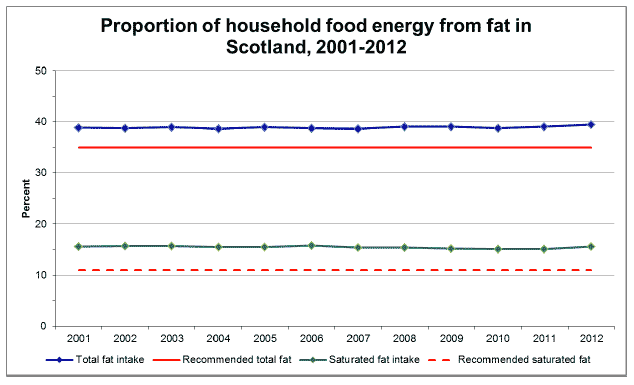Obesity Indicators 2014
This publication reports the latest available data for 16 indicators selected to monitor progress for the Prevention of Obesity Route Map. Most indicators are updated up to 2013, but for some indicators data is more or less up-to-date than this.
This document is part of a collection
Total and saturated fat: average intake as a percentage of food energy
Indicator Source: Food Standards Agency (FSA) Scotland
LATEST RESULTS
- In 2012, the percentage of household food energy from all fats remained at 39%, above the recommendation of no more than 35%.
- The percentage of food energy from saturated fat was 15.5%, compared with the recommendation of no more than 11%

- In 2010, the mean intake of total fat as percentage food energy for children was lower than the recommended levels (<35%). However, the intake of saturated fat was above the recommended level of less than 11% food energy for both boys and girls.
Proportion of food energy intake from fat among children in Scotland (aged 3-16), 2006 & 2010
| 2006 |
2010 |
|||
|---|---|---|---|---|
| Boys |
Girls |
Boys |
Girls |
|
| Total Fat |
32.9% |
33.0% |
32.7% |
32.8% |
| Saturated Fat |
13.9% |
13.7% |
13.3% |
13.0% |
Source: FSA Scotland, Survey of sugar intake among children in Scotland
ABOUT THIS INDICATOR
Desired Outcome:
Reduced energy intake.
Relevant Route Map action:
All energy consumption actions.
Indicator Sources:
Food Standards Agency (FSA) Scotland analysis of data from the ONS Living Cost and Food Survey. Estimated nutrient intakes are calculated from household food purchases following secondary analysis to convert purchase data to mean per capita consumption and nutrient intakes and to allow meaningful comparisons to be made between years.
The FSA Scotland Survey of sugar intake among children in Scotland includes figures for children on total and saturated fatty acids as percentage of total energy intake.
Equalities:
Information is collected on differences in food and nutrient intake by deprivation (using the Scottish Index of Multiple Deprivation (SIMD)).
Geography available: Population level information is collected on differences in food and nutrient intake by urban/rural classification.
Rationale for including this indicator:
The aim of this indicator is to monitor change in the proportion of the population consuming energy dense foods. Currently people are eating more saturated fat on average than is recommended (FSAS Barton et al, 2010). Rising levels of obesity indicate that energy intakes currently exceed energy requirements (SHeS). Both these issues raise serious health concerns, particularly in relation to coronary heart disease, high blood pressure, stroke, type 2 diabetes and certain types of cancers (SHeS).
Recommendations for food and nutrient intake are based on advice from the Committee on Medical Aspects of Food and Nutrition Policy (COMA) and the Scientific Advisory Committee on Nutrition (SACN). Published Dietary Reference Values cover a range of intakes for most nutrients and for fat and saturated fat are set as a percentage of daily energy intake for adults.
Factors influencing this indicator:
- Availability, cost, and access to different food types.
Contact
Email: Daniel Adams
There is a problem
Thanks for your feedback